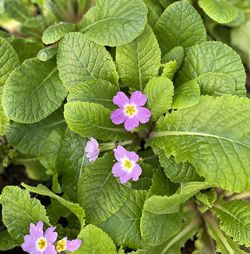Eupatorium
Joe-Pye Weed
Many have discovered the curative aspects of Eupatorium, yet only two have lent it their names: Eupator, a King of Pontus, and a Native American named Joe-Pye. We prescribe these undemanding perennials for whatever ails your garden. Some delegate this rather coarse and undeniably valiant member of the Asteraceae family to meadow gardens, but we’ve found that Eupatorium can provide balance and stability to formal situations as well. Best of all, butterflies love them!
Eupatorium maculatum ‘Glutball’ (P-2068)
OUT OF PRODUCTION AT THIS TIME
Email me when this plant is available
This coveted, tall-standing cultivar is named for its enormous, nearly ball-shaped umbels and warm glowing tones. Characterized by a hushed, easy-to-meld hue, the arresting plum-purple panicles surmount lustrous, straight-backed red stems. Dark green whorls of dashing, large, pointy serrated leaves with burgundy midribs clothe ‘Glutball’s grand frame that can be staged in borders or meadows, and added to floral arrangements, while wielding a majestic presence well into fall.
Blooms August–October
Size: 6' 0" – 7' 0" high x 3' 0" wide.
Hardy to zone 4.
Earning an AGM for its handsome, compact bushy habit and irresistible long-lasting floral spectacle, this easy-care late season bloomer touts a shorter more manageable height than its towering brethren. Durable upright purple-flecked stems garbed with whorled lance-like deep green leaves hoist the soft-looking broad domes of hushed rosy-purple flowers that are arranged in a looser, less snug fashion. Enjoyed by swallows, butterflies and numerous bee species, ‘Purple Bush’ creates splendid color echoes amongst Persicaria ‘Purple Spear’ and Veronicastrum ‘Cupid’.
Blooms August–September
Size: 4-1/2' – 5' 0" high x 2' 0" wide.
Hardy to zone 4.
Eupatorium maculatum ‘Riesenschirm’ (P-1754)
Each $12.75
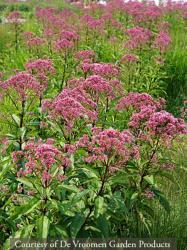
An AGM recipient, a magnet for bees and butterflies and one of the top 10 plants of the Dutch “wave,” this superb back-of-the-border beauty propels tall, polished, dark purple stems—stiff, straight and mighty—skyward bound. Loosely arranged whorls of heavily textured deep green tapered leaves anchor fluffy 8 in. wide domed flower heads awash with reddish purple hues. Its lofty architecture maintains a dignified profile, even in winter, enhanced by mulled brown shades and attractive seed heads, which nourish finches and tits.
Blooms August–October
Size: 5' 0" – 7' 0" high x 3' 0" wide.
Hardy to zone 4.
Each $12.00
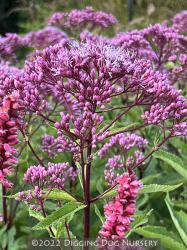
This robust cousin is from the taller side of the family (up to 6 or 7 ft.), and shares the wine red stem coloring of its smaller kin. Eupatorium purpureum features a stately carriage with broad, domed heads hosting purple-mauve flowers. It’s tough, reliable and effective for the back of the border.
Blooms September–October.
Size: 6' 0" high x 2' 0" wide.
Hardy to zone 4.
Eupatorium maculatum ‘Gateway’ (P-0067)
Each $12.75

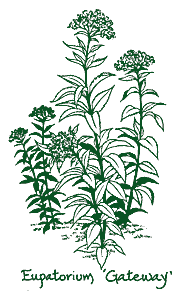
In late spring, ‘Gateway’s vigorous shoots burst through the mulch. Wine-colored stems develop large green coriaceous leaves, lending mass to the middle or rear of a mixed planting. Dense, broad flower clusters present a lavender-purple that’s both strong and soft. This uniquely muted color feels like fall and blends well with other late bloomers such as Rudbeckia or Aster ‘Bluebird’.
Blooms August–September
Size: 4' 0" high x 2' 0" wide.
Hardy to zone 4.
Eupatorium rugosum ‘Chocolate’ (P-0691)
Each $11.75
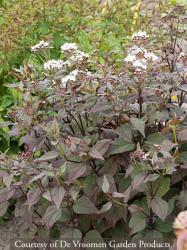
Sumptuous and shiny, crinkled reddish chocolate foliage adorns the erect purple stems of this standout cultivar, selected by Richard Lighty from the eastern native White Snakeroot. With Physocarpus ‘Dart’s Gold’ as a neighbor, Eupatorium ‘Chocolate’ adds rich accents to our mixed border, while in late summer, terminal corymbs of tiny white flowers seem to sparkle against the dark leaves.
Blooms August–September
Size: 4' 0" high x 2-1/2' wide.
Hardy to zone 4.
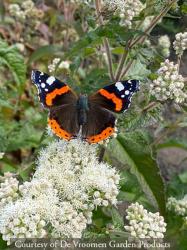
A selection from Piet Oudolf’s Hummelo Nursery, this energetic upright perennial champions large luminous domes shouldered by tall swarthy stems. Good-sized ovate green leaves garb the attractive compact habit beneath a generous late-season parade of ivory-white flowers that bees and butterflies fancy. Happiest in moist soil with protection from hot afternoon sun, ‘Snowball’ glitters against a dark backdrop, lending lively highlights to sizable cohorts such as Helianthus ‘Gold Lace’ and Aster ‘Nachauge. (pp#22,869)
Blooms August–October
Size: 4' 0" – 4-1/2' high x 2-1/2' – 3' 0" wide.
Hardy to zone 4.
Eupatorium
Joe-Pye Weed
Many have discovered the curative aspects of Eupatorium, yet only two have lent it their names: Eupator, a King of Pontus, and an American Indian named Joe-Pye. We prescribe these undemanding perennials for whatever ails your garden. Some delegate this rather coarse and undeniably valiant member of the Asteraceae family to meadow gardens, but we’ve found that Eupatorium can provide balance and stability to formal situations as well. Best of all, butterflies love them!
Eupatorium maculatum ‘Glutball’ (P-2068)
OUT OF PRODUCTION AT THIS TIME
Email me when this plant is available
This coveted, tall-standing cultivar is named for its enormous, nearly ball-shaped umbels and warm glowing tones. Characterized by a hushed, easy-to-meld hue, the arresting plum-purple panicles surmount lustrous, straight-backed red stems. Dark green whorls of dashing, large, pointy serrated leaves with burgundy midribs clothe ‘Glutball’s grand frame that can be staged in borders or meadows, and added to floral arrangements, while wielding a majestic presence well into fall.
Blooms August–October
Size: 6' 0" – 7' 0" high x 3' 0" wide.
Hardy to zone 4.
Earning an AGM for its handsome, compact bushy habit and irresistible long-lasting floral spectacle, this easy-care late season bloomer touts a shorter more manageable height than its towering brethren. Durable upright purple-flecked stems garbed with whorled lance-like deep green leaves hoist the soft-looking broad domes of hushed rosy-purple flowers that are arranged in a looser, less snug fashion. Enjoyed by swallows, butterflies and numerous bee species, ‘Purple Bush’ creates splendid color echoes amongst Persicaria ‘Purple Spear’ and Veronicastrum ‘Cupid’.
Blooms August–September
Size: 4-1/2' – 5' 0" high x 2' 0" wide.
Hardy to zone 4.
Eupatorium maculatum ‘Riesenschirm’ (P-1754)
Each $12.75

An AGM recipient, a magnet for bees and butterflies and one of the top 10 plants of the Dutch “wave,” this superb back-of-the-border beauty propels tall, polished, dark purple stems—stiff, straight and mighty—skyward bound. Loosely arranged whorls of heavily textured deep green tapered leaves anchor fluffy 8 in. wide domed flower heads awash with reddish purple hues. Its lofty architecture maintains a dignified profile, even in winter, enhanced by mulled brown shades and attractive seed heads, which nourish finches and tits.
Blooms August–October
Size: 5' 0" – 7' 0" high x 3' 0" wide.
Hardy to zone 4.
Each $12.00

This robust cousin is from the taller side of the family (up to 6 or 7 ft.), and shares the wine red stem coloring of its smaller kin. Eupatorium purpureum features a stately carriage with broad, domed heads hosting purple-mauve flowers. It’s tough, reliable and effective for the back of the border.
Blooms September–October.
Size: 6' 0" high x 2' 0" wide.
Hardy to zone 4.
Eupatorium maculatum ‘Gateway’ (P-0067)
Each $12.75


In late spring, ‘Gateway’s vigorous shoots burst through the mulch. Wine-colored stems develop large green coriaceous leaves, lending mass to the middle or rear of a mixed planting. Dense, broad flower clusters present a lavender-purple that’s both strong and soft. This uniquely muted color feels like fall and blends well with other late bloomers such as Rudbeckia or Aster ‘Bluebird’.
Blooms August–September
Size: 4' 0" high x 2' 0" wide.
Hardy to zone 4.
Eupatorium rugosum ‘Chocolate’ (P-0691)
Each $11.75

Sumptuous and shiny, crinkled reddish chocolate foliage adorns the erect purple stems of this standout cultivar, selected by Richard Lighty from the eastern native White Snakeroot. With Physocarpus ‘Dart’s Gold’ as a neighbor, Eupatorium ‘Chocolate’ adds rich accents to our mixed border, while in late summer, terminal corymbs of tiny white flowers seem to sparkle against the dark leaves.
Blooms August–September
Size: 4' 0" high x 2-1/2' wide.
Hardy to zone 4.

A selection from Piet Oudolf’s Hummelo Nursery, this energetic upright perennial champions large luminous domes shouldered by tall swarthy stems. Good-sized ovate green leaves garb the attractive compact habit beneath a generous late-season parade of ivory-white flowers that bees and butterflies fancy. Happiest in moist soil with protection from hot afternoon sun, ‘Snowball’ glitters against a dark backdrop, lending lively highlights to sizable cohorts such as Helianthus ‘Gold Lace’ and Aster ‘Nachauge. (pp#22,869)
Blooms August–October
Size: 4' 0" – 4-1/2' high x 2-1/2' – 3' 0" wide.
Hardy to zone 4.











